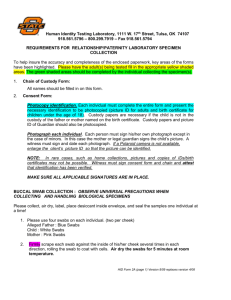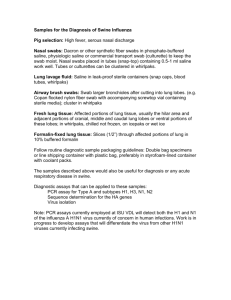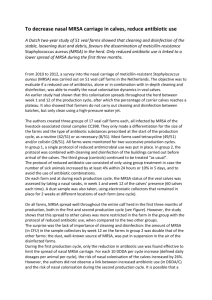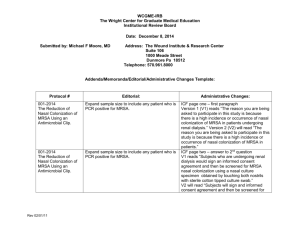Open Access version via Utrecht University Repository
advertisement
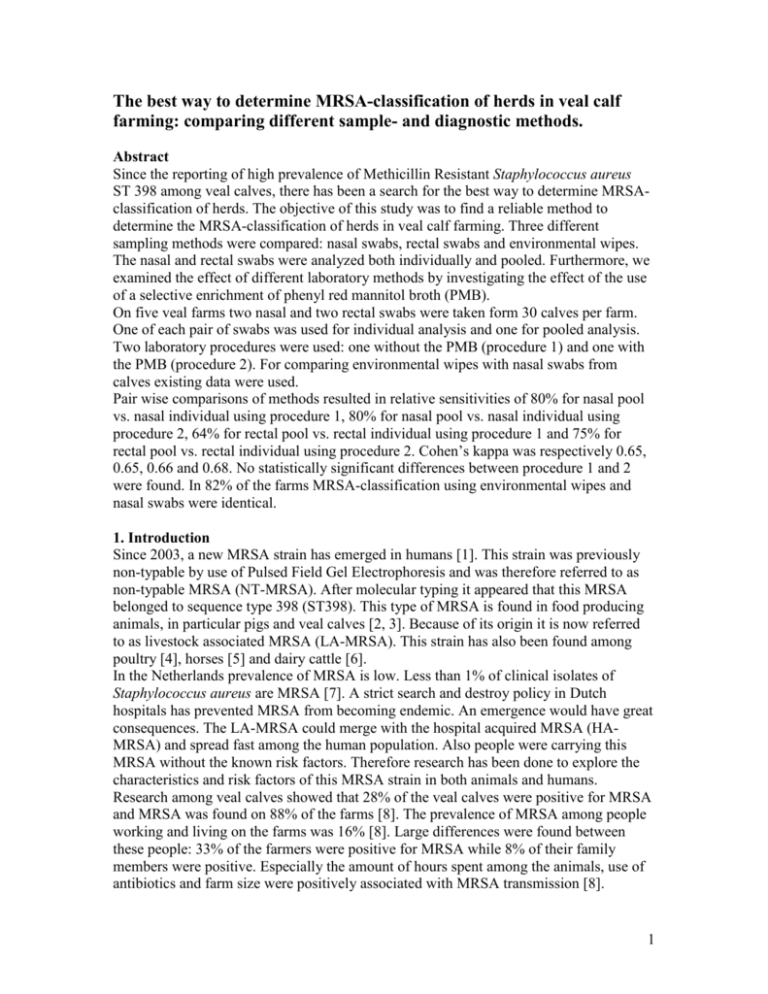
The best way to determine MRSA-classification of herds in veal calf farming: comparing different sample- and diagnostic methods. Abstract Since the reporting of high prevalence of Methicillin Resistant Staphylococcus aureus ST 398 among veal calves, there has been a search for the best way to determine MRSAclassification of herds. The objective of this study was to find a reliable method to determine the MRSA-classification of herds in veal calf farming. Three different sampling methods were compared: nasal swabs, rectal swabs and environmental wipes. The nasal and rectal swabs were analyzed both individually and pooled. Furthermore, we examined the effect of different laboratory methods by investigating the effect of the use of a selective enrichment of phenyl red mannitol broth (PMB). On five veal farms two nasal and two rectal swabs were taken form 30 calves per farm. One of each pair of swabs was used for individual analysis and one for pooled analysis. Two laboratory procedures were used: one without the PMB (procedure 1) and one with the PMB (procedure 2). For comparing environmental wipes with nasal swabs from calves existing data were used. Pair wise comparisons of methods resulted in relative sensitivities of 80% for nasal pool vs. nasal individual using procedure 1, 80% for nasal pool vs. nasal individual using procedure 2, 64% for rectal pool vs. rectal individual using procedure 1 and 75% for rectal pool vs. rectal individual using procedure 2. Cohen’s kappa was respectively 0.65, 0.65, 0.66 and 0.68. No statistically significant differences between procedure 1 and 2 were found. In 82% of the farms MRSA-classification using environmental wipes and nasal swabs were identical. 1. Introduction Since 2003, a new MRSA strain has emerged in humans [1]. This strain was previously non-typable by use of Pulsed Field Gel Electrophoresis and was therefore referred to as non-typable MRSA (NT-MRSA). After molecular typing it appeared that this MRSA belonged to sequence type 398 (ST398). This type of MRSA is found in food producing animals, in particular pigs and veal calves [2, 3]. Because of its origin it is now referred to as livestock associated MRSA (LA-MRSA). This strain has also been found among poultry [4], horses [5] and dairy cattle [6]. In the Netherlands prevalence of MRSA is low. Less than 1% of clinical isolates of Staphylococcus aureus are MRSA [7]. A strict search and destroy policy in Dutch hospitals has prevented MRSA from becoming endemic. An emergence would have great consequences. The LA-MRSA could merge with the hospital acquired MRSA (HAMRSA) and spread fast among the human population. Also people were carrying this MRSA without the known risk factors. Therefore research has been done to explore the characteristics and risk factors of this MRSA strain in both animals and humans. Research among veal calves showed that 28% of the veal calves were positive for MRSA and MRSA was found on 88% of the farms [8]. The prevalence of MRSA among people working and living on the farms was 16% [8]. Large differences were found between these people: 33% of the farmers were positive for MRSA while 8% of their family members were positive. Especially the amount of hours spent among the animals, use of antibiotics and farm size were positively associated with MRSA transmission [8]. 1 Until now, the majority of the studies investigating herd prevalence and risk factors associated with MRSA in animals used nasal swabs, rectal swabs or environmental wipes [8-12]. Khanna et al., (2008) found in pigs results from nasal swabs to be significantly different from the results of the rectal swabs. Prevalence found with nasal swabs, were higher than prevalence found with rectal swabs. All of those that tested positive for rectal swabs only were weanlings. Besides different sampling methods, different laboratory analyses were applied, such as individual sample analysis and pooled sample analysis [11]. Pooling samples reduces the costs of MRSA detection. Less analyses have to be performed, wich reduces time and materials needed. The disadvantages can be a decrease in sensitivity and/or an increase in false positive results (because of cross-contamination and cross-reaction)[12]. For example, Broens et al. (2010) found a large difference in apparent prevalence of MRSA positive herds of breeding pigs while using individual environmental wipes and pooled environmental wipes (53,1% resp. 19,1%). Different procedures and agars can be used for detection of MRSA [8, 9,10,11] Graveland et al. (2009) evaluated isolation procedures and chromogenic agars for the detection of MRSA both in pigs and in veal calves, and found that more positive samples were detected while using a Mueller Hinton broth as pre-enrichment. No differences were observed between the different agars used for samples from veal calves [14]. Thus there are various ways one can best detect MRSA in one species or another. Wertheim et al. (2001) found that the use of PMB increased the rate of MRSA detection in human clinical samples [15]. Graveland et al. (2009) used a selective enrichment in all the procedures studied, and found no differences between procedures for veal calf samples. However, the effect of PMB on samples from veal calves has never been examined. If this step could be skipped without a significant effect on MRSA detection, expenses could be reduced further. Thus the type of samples, laboratory analysis and lab techniques influence the rate of MRSA detection and by that the MRSA-classification of a herd. In this study we compare different sampling and laboratory methods to determine the most optimal method for quantifying farm MRSA status in veal calves. 2. Materials and methods 2.1 Study design 2.2.1. Individual vs. pooled analysis and procedure 1 vs. procedure 2 From October 2010 to December 2010 five veal calf farms were visited. On each farm 30 calves were randomly selected and sampled using a sterile cotton-wool swab (Cultiplast®). From each calf two nasal and two rectal swabs were taken; one swab was used for individual analyses and one for pooled analyses, selection occurred randomly. Each pool contained six swabs. These swabs were taken from calves from the same section (a section was considered a group of calves with mutual contact). Thus on each farm five sections were selected. The nasal swabs were taken from both anterior nares by rubbing the swab in each nostril. The rectal swabs were taken from the rectum by putting the swab about 1 cm into the rectum. The swabs were immediately transported to the laboratory and processed within four hours after collection. 2 2.2.2. Individual nasal swabs vs. environmental wipes Environmental wipes were taken and analyzed as previously described [11]. The environmental wipes and nasal swabs were taken during the cross-sectional study of Graveland et al. (2010). Environmental wipes (n=5) and nasal swabs (square root of the number of veal calves, with a minimum of 10 and a maximum of 25) were taken from 102 farms which were visited form October 2007 to March 2008. A herd was classified negative if no MRSA was found in neither the nasal swabs of the calves nor environmental wipes. A herd was classified positive if one or more nasal swab or environmental wipe were positive. Based on nasal swabs only, 22 farms were classified negative for MRSA and 80 farms were classified positive for MRSA. Based on environmental wipes only, 18 farms were classified negative for MRSA and 84 farms were classified positive for MRSA. 11 herds were classified negative for MRSA. 73 herds were classified positive for MRSA. For 18 herds results from nasal swabs and environmental wipes didn’t match (one positive while the other was negative) (Table 5). In 33% (6/18) of the cases the nasal swabs were positive while the environmental wipes were negative for MRSA. In 67% (12/18) of the cases the nasal swabs were negative while the environmental wipes were positive for MRSA. 2.2 Laboratory analysis A total of 600 swabs were taken from 150 calves; 300 nasal and 300 rectum swabs. Half of these swabs were pooled and analyzed, the other half of these swabs were analyzed individually (figure 1). One pool of swabs contained 6 swabs. In total 50 pools were analyzed; 25 pools of nasal swabs and 25 pools of rectal swabs. The nasal and rectal swabs for both individual and pooled analyses were analyzed according 2 different procedures and are described below. Procedure 1 (with PMB) and procedure 2 (without PMB). Both procedures used the same pre-enrichment step with Mueller Hinton broth was used for both procedures (figure 1). 2.2.1 Procedure 1 Swabs were inoculated into tubes containing 5 ml Mueller Hinton broth (MH) (Becton Dickenson) with 6,5% NaCl and incubated overnight by 37ºC. After 16-20 hours 1 mL of the pre-enrichment was transferred into 9 mL selective enrichment containing phenyl red mannitol broth (PMB) (bioMérieux) with 75 mg/L aztreonam and 5 mg/L ceftizoxime and incubated overnight by 37ºC. After overnight incubation 10 µL of the phenyl red mannitol broth was inoculated onto sheep blood agar and MRSA Brilliance™ agar. 2.2.2 Procedure 2 Procedure 2 was similar to procedure 1. However after overnight incubation in Mueller Hinton broth 10 µL of the Mueller Hinton broth was directly inoculated onto sheep blood agar (Biotrading, The Netherlands) and a MRSA Brilliance™ agar (Oxoid, The Netherlands). No selective enrichment containing PMB was used in this procedure. 3 Swabs (n = 600) Pool (n = 50; 6 swabs per pool) Individual (n = 300) MH MH PMB Blood Agar MRSA Brilliance PMB Blood Agar Blood Agar MRSA Brillinace MRSA Brilliance Blood Agar MRSA Brilliance Figure 1. Laboratory analysis All suspected colonies were pure inoculated on a new sheep blood agar and identified as an S. aureus after positive slide coagulase assay with rabbit serum. The presence of the mecA gene was confirmed by PCR [16]. 2.3 Data analysis Statistical analysis was performed using SAS software version 9.2. For comparing individual and pooled prevalence, relative sensitivity and specificity were calculated. A pool was considered false negative if among the duplo swabs used for individual analysis one or more swabs were positive. A pool was considered false positive if among the duplo swabs used for individual analysis no positive swabs were found. Cohen’s kappa was calculated using the PROC FREQ procedure. Differences in prevalence as resulting form procedures 1 and 2 were calculated with Chi2-test (PROC FREQ procedure). A P-value of <0.05 was considered statistically significant. Further the association between environmental wipes and nasal swabs was investigated using logistic regression with nasal swabs as the independent variable. 3. Results Nasal and rectal swabs were taken from 150 veal calves from five farms. The general characteristics of the study population are shown in table 1. The overall prevalence (both positive individual nasal and rectal swabs) of MRSA was 22% (65/300). Table 2. shows the number of MRSA positive samples found for each procedure separately. 4 Table 1. Characteristics of veal calves Veal calves Number of antibiotic group treatments 1 2 3 4 5 6 Age calf (wk) 6 7 Kept in baby box Yes No No. of calves 150 (5 farms) 30 30 0 30 30 30 60 90 30 120 Table 2. Prevalence of MRSA in veal calves resulting from different sampling and laboratory procedures. No. of calves (%) Method Overall procedure 1 55 (18) Overall procedure 2 65 (22) Individual Nasal procedure 1 18 (12) Nasal procedure 2 27 (18) Rectal procedure 1 37 (25) Rectal procedure 2 38 (25) Pools Nasal procedure 1 6 (24) Nasal procedure 2 9 (36) Rectal procedure 1 7 (28) Rectal procedure 2 10 (40) 3.1 Individual verses pooled analysis In four farms herds were classified positive for MRSA based on both individual analysis and pooled analysis. One farm however one nasal pool was positive while all the nasal individual swabs were negative. Also one individual rectal swab was positive while all the rectal pools were negative. The relative sensitivity was 80.0% when comparing nasal pool with nasal individual samples using procedure 1, 80.0% comparing nasal pool with nasal individual using 5 procedure 2. For rectal samples the relative sensitivity was 63.6% comparing rectal pool with rectal individual samples using procedure 1 and 75.0% comparing rectal pool with rectal individual samples using procedure 2. Relative specificity was respectively 90.0% (procedure 1), 86.7% (procedure 2), for nasal swabs 100% (procedure 1) and 92.3% (procedure 2) for rectal swabs. Cohen’s kappa was 0.65 for nasal samples procedure 1, 0.65 for nasal samples procedure 2, 0.66 for rectal samples procedure 1 and 0.68 for rectal samples procedure 2 (Table 3), thus varying between moderate and good agreement. Table 3. Relative sensitivity, relative specificity and Cohen’s kappa of pooled analysis compared with individual (ind.) analysis for both procedures 1 (MH) and 2 (PMB). compared methods MH Nasal pool vs. ind. PMB Nasal pool vs. ind. MH Rectal pool vs. ind. PMB Rectal pool vs. ind. relative sensitivity (exact 95% CI) 80.0 (29.9-98.9) 80.0 (44.2-96.6) 63.6 (31.6-87.6) 75.0 (42.8-93.3) relative specificity (exact 95% CI) 90.0 (66.9-98.2) 86.7 (58.4-97.7) 1 (73.2-1) 92.3 (62.1-99.6) Cohen’s kappa (95% CI) 0.65 (0.29-1) 0.65 (0.34-0.96) 0.66 (0.38-0.95) 0.68 (0.39-0.96) 3.2 Procedures 1 and 2 The total prevalence of MRSA in 300 individual samples (thus nasal and rectal samples together) using procedure 1 was 18% (55). The prevalence using procedure 2 was 22% (65). Prevalence found in nasal swabs (n=150) was 12% (18) using procedure 1 and 18% (27) using procedure 2. In the rectal swabs (n=150) prevalence was 25% (37) and 25% (38) respectively. More MRSA was found using procedure 2 in the pooled analysis. In the pooled analysis of the nasal swabs (n=25) prevalence was 24% (6) using procedure 1 and 36% (9) using procedure 2. In the pools of the rectal swabs (n=25) prevalence was 28% (7) and 40% (10) respectively (Table 2). No significant difference between procedures 1 and 2 was found (Table 4). Although not statistically significant we detected more MRSA-positive samples with procedure 2 as shown by differences in prevalence. Overall of individual swabs (nasal and rectal swabs) 3% (10) more positive samples were found with procedure 2 compared to procedure 1. In individual nasal swabs 9 (33%) more positive samples were found with procedure 2. In individual rectal swabs however, only 1 (2%) more positive sample was found. In overall, of the pools 6 (12%) more positive pools were found; 3 (12%) nasal pools and 3 (12%) rectal pools. 6 Table 4. Comparison of procedure 1 (MH) and 2 (PMB) for individual and pooled analysis with a Chi2-test No. (%) Chi2 MH PMB value prob* Indiv. Nasal 18 (12) 27 (18) 2.12 0.15 Indiv. Rectal 37 (25) 38 (25) 0.02 0.89 Pool Nasal 6 (24) 9 (36) 0.86 0.35 Pool Rectal 7 (28) 10 (40) 0.80 0.37 * P>0.05 3.3 Individual nasal swabs and environmental wipes Statistical analysis of the dataset previously collected showed that there is no significant difference between results from environmental wipes (dependent variable) and nasal swabs (independent variable) of the animals on the farm (p<0.05). Table 5. Classification of herd with nasal swabs and environmental wipes No. (%) Positive herd Negative herd Total (nasal swabs) Positive farm (nasal swabs) 73 (72) 12 (12) 85 (83) 6 (6) 11 (11) 17 (17) 79 (77) 23 (23) 102 (100) (environmental wipes) Negative farm (environmental wipes) Total 4. Discussion This study showed that more MRSA positive samples were found using individual analysis of rectal swabs from veal calves, compared to nasal samples. This was shown for both procedure 1 and procedure 2. Relative sensitivity for individual nasal swabs and pooled nasal swabs with procedure 1 was 80%, with procedure 2, relative sensitivity was 80%. Relative sensitivity for individual rectal swabs and pooled rectal swabs with procedure 1 was 63.6% and for procedure 2 75%. Furthermore there was no significant difference in prevalence of MRSA between procedure 1 and procedure 2. Also no significant difference between results from environmental wipes and nasal swabs was found. Whether veal calves are positive for MRSA on a nasal or rectal swab seems, according to unpublished results, to depend on age of the calves. This is also known for pigs [9]. Calves sampled in this study were 6-7 weeks old, and therefore within this study no age effect could be shown. However, these unpublished results have already shown that in younger calves (age of 6 to 8 weeks) rectal MRSA carriage seems higher than nasal MRSA carriage. This could be an explanation for the higher MRSA prevalence using rectal swabs, found in this study. While comparing pooled analysis with individual analysis we assumed that both swabs taken from one calf would both be either positive or negative. However, it is possible that one swab was positive for MRSA while the other was negative. The repeatability of the 7 used methods is not optimal (unpublished data). The false positive/negative pools could have been truly positive or negative because the swabs that were used for pooled analysis differed from the ones used for individual analysis. So the results from comparing individual analysis with pooled analysis can be underestimated. Calculated relative sensitivities were generally high. Nevertheless, MRSA prevalence has a large influence. Muñoz-Zanzi et al. (2005) found that one of the factors that influence the sensitivity of a test of pooled samples is the prevalence of the bacterium [12]. We found that when prevalence of MRSA within a herd was extremely low or extremely high according to the results from individual swabs the prevalence found with pooled analysis was also low or high. This because there either were no positive swabs in the pool or almost every swab in the pool was positive. If almost every swab in a pool is positive (prevalence on a farm is high), the chance for a pool being positive is much higher. If almost every swab in a pool is negative (prevalence on a farm is low), the chance for a pool being negative is much higher. If prevalence of MRSA in a herd was average, based on the individual swabs, the relative sensitivity was low. Relatively less positive swabs were in a pool, so the chance of a pool being positive decreased because of dilution. Concentrations of MRSA fall within the ambit of the detection limit which causes false negative results (leading to a decrease in sensitivity). The PMB used in procedure 2 did not have a statistically significant effect on the amount of detected positive swabs. This in contrast with what Wertheim found for samples from human origin [15]. Nevertheless it had a positive effect on the comfortableness of reading off the agars in the lab. All the agars showed mixed cultures but it was far less on the agars that had been inoculated using procedure 2 than on the agars inoculated using procedure 1. Also fewer agars (and days) have to be used to get a pure culture. So if one is not very well trained in reading of the agars or has a lot to read off in one day, procedure 2 can be a recommendation. Procedure 2 has a lager effect on nasal swabs then on rectal swabs. 9 more positive individual nasal swabs were found in procedure 2 compared to procedure 1 (all the swabs that were positive in procedure 1 were positive in procedure 2). In individual rectal swabs however, only 1 more positive swab was found with procedure 2 compared to procedure 1. Why this is, is not clear. MRSA can survive for longer than six months in dust [17]. With environmental wipes MRSA that is found in dust in the environment can be detected. One must keep in mind that by doing so one classifies the farm but not the animals. The MRSA found using environmental wipes can derive from animals from the previous production round. In the data collected previously we found that in 18 out of 102 farms results from the environmental wipes and nasal swabs did not conform. In 12 of the 18 farms we found that the environmental wipes were positive and the nasal swabs were negative. This can be explained by the difference in what was really tested. If an environmental wipe is positive the farm is classified positive for MRSA. If the nasal swabs are positive the herd is classified positive. In this study however we also found that 82% of the farms results from both environmental wipes and nasal swabs agreed. Thus it is more common that when a herd is positive, MRSA will be found in dust from the environment. To exclude 8 the possibility that the MRSA in dust derived from animals from the previous round the farm must be cleaned and disinfected between rounds. In Broens et al. (2010) three sampling methods for MRSA-classification of herds with breeding pigs were compared: pools of nasal swabs (one pool containing 6 swabs) and single environmental wipes. With 10 pools of nasal swabs more MRSA positive herds were detected than with 5 single environmental wipes. This might be due to the difference in 10 versus 5 samples to classify a herd, but might also be due to a difference in MRSA load between pigs and the environment. Nevertheless, the agreement between herd classification based on 5 single environmental wipes and based on 10 pools of nasal swabs was moderate (κ = 0.55), which was promising for future monitoring and surveillance programs for breeding pigs. In this study single environmental wipes were compared with single nasal swabs. A Cohen’s kappa was not calculated. However, there was an agreement of 82% for classifying herds of calves based on both environmental wipes and nasal swabs. In conclusion: pooling is a rather reliable method for classifying herds of veal calves. Nasal swabs had a higher relative sensitivity than rectal swabs and are therefore preferred. No significant difference between procedures 1 and 2 was found and can be deleted from the protocol. Environmental wipes are a rather reliable method for classifying herd of veal calves. References 1. van Loo I, Huijsdens X, Tiemersma E, de Neeling A, van de Sande-Bruinsma N (2007) Emergence of methicillin-resistant Staphylococcus aureus of animal origin in humans. Emerg Infect Dis 13: 1834-1839. 2. de Neeling AJ, van den Broek MJ, Spalburg EC, van Santen-Verheuvel MG, DamDeisz WD (2007) High prevelence of methicillin resistant Staphylococcus aureus in pigs. Vet Microbiol 21: 366-372. 3. Voss, A, Loeffen, F, Bakker J, Klaassen C, Wulf M (2005) Methicillin-resistant Staphylococcus aureus in pig farming. Emerg. Infect. Dis. 11: 1965–1966. 4. Mulders MN, Heanen APJ, Geenen PL, Versseur PC, Poldervaart ES, Bosch T, Huijsdens XW, Hengeveld PD, Dam-Deisz WDC, Graat EAM, Mevius D, Voss A, van de Giessen AW (2010). Prevalence of livestock-associated MRSA in broiler flocks and risk factors for slaughterhouse personnel in The Netherlands. Epidemiology and Infection, 138: 743-755 5. van den Eede A, Martens A, Lipinska U, Struelens M, Deplano A, Denis O, Haesebrouck F, Gasthuys F, Hermans K (2009) High occurrence of methicillin- 9 resistant Staphylococcus aureus ST398 in equine nasal samples.Vet. Microbiol. 133: 138–144. 6. Vanderhaeghen W, Cerpentier T, Adriaensen C, Vicca J,Hermans K, Butaye P (2009) Methicillin-resistant Staphylococcus aureus (MRSA) ST398 associated with clinical and subclinical mastitis in Belgian cows. Vet. Microbiol. 144: 166–171. 7. Wertheim HF, Vos MC, Boelens HA (2004) Low prevalence of methicillinresistant Staphylococcus aureus (MRSA) at hospital admission in the Netherlands: the value of search and destroy and restrictive antibioticuse. J Hosp Infect 56: 321–325. 8. Gravenland H, Wagenaar JA, Heesterbeek H, Mevius D, van Duijkeren E, Heederik D (2010) Methicillin Resistant Staphylococcus aures ST398 in veal calf farming: human MRSA carriage related with animal antimicrobial usage and farm hygiene, the Netherlands. PLoS ONE 5(6): e10990. 9. Khanna T, Friendship R, Dewey C, Weese JS (2008) Methicillin resistant Staphylococcus aureus colonization in pigs and pig farmers. Vet Microbiol 128: 298– 303. 10. Smith TC, Male MJ, Harper AL, Kroeger JS, Tinkler GP, Mortiz ED, Capuano AW, Herwaldt LA, Diekema DJ (2008) Methicillin-resistant Staphylococcus aureus (MRSA) strain ST398 is present in Midwestern U.S. swine and swine workers. PLoS ONE 4, e4258 11. van de Broek IVF, van Cleef BAGL, Haenen A, Broens EM, van der Wolf PJ, van den Broek MJ, Huijsdens XW, Kluytmans JA, van de Giessen AW, Tiemersma EW (2009) Methicillin-resistant Staphylococcus aureus in people living and working in pig farms. Epidemiol. Infect. 137: 700-708. 12. Muñoz-Zanzi C, Thurmond M, Hietala S, Johnson W (2005) Factors affecting sensitivity of pooled-sample testing for diagnosis of low prevalence infections, United States. Prev. Vet. Med. 74: 309-322. 13. Broens EM, Graat EAM, Engel B, van Oosterom RAA, van Giessen AW, van der Wolf PJ (2010) Comparison of sampling methods used for MRSA-classification of herds with breeding pigs. Vet Microbiol, doi:10.1016/j.vetmic.2010.07.021. 14. Gravenland H, van Duijkeren E, van Nes A, Schoormans A, Broekhuizen-Stins M, Oosting-van Schothorst I, Heederick D, Wagenaar JA (2009) Evaluation of isolation procedures and chromogenic agar media for the detection of MRSA in nasal swabs form pigs and veal calves, the Netherlands. Vet. Microbiol. 139: 121-125. 10 15. Wertheim H, Verbrugh HA, van Pelt C, de Man P, van Belkum A, Vos MC (2001) Improved detection of Methicillin-Resistant Staphylococcus aureus using phenyl mannitol broth containing aztreonam and ceftizoxime. J Clin Microbiol 2660-2662 16. Fluit AC, Wielders CL, Verhoef J, Schmitz FJ (2001) Epidemiology and susceptibility of 3,051 Staphylococcus aureus isolates from 25 university hospitals participating in the European SENTRY study. J Clin Microbiol 39: 3727–3732. 17. Wagenvoort J, Sluijsmans W, Penders RJR (2000) Better environmental survival of outbreak vs. sporadic MRSA isolates. J Hosp Infect 45: 231-234 11
